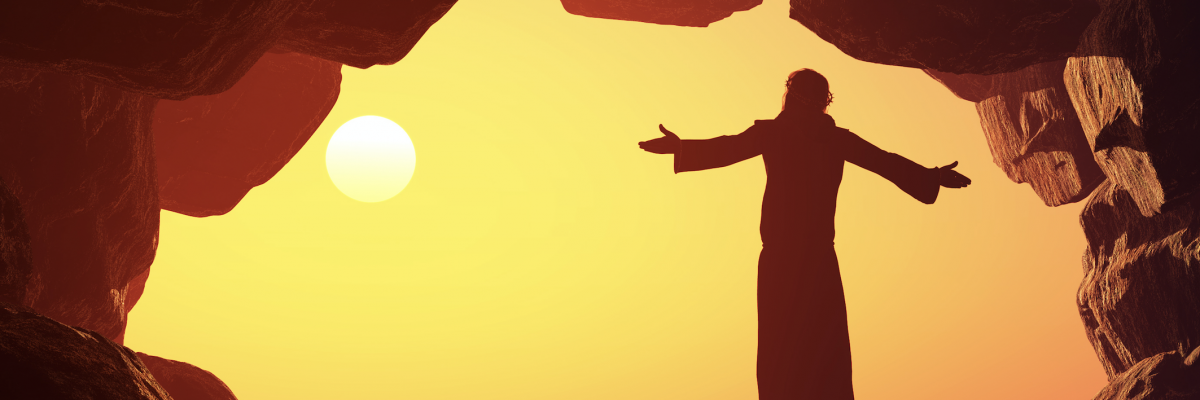
The third day after his death, Christ rose gloriously from the dead. But did you ever wonder what Christ’s resurrected body was made of? This is not a question of incredulity, but one of unflinching, child-like trust that Christ’s resurrected body was real, not a figment of imagination, not an aberration, not a ghost, but actually there, walking, talking, eating, appearing, and vanishing among the disciples in exactly the way Christ intended it. The saints and Church have provided us with guidance that is just as relevant in terms of modern science as it was in antiquity.
The resurrected body is real
The reality of the resurrected body is a fundamental truth of Christianity. The Eleventh Synod of Toledo (A.D. 675) held that Christ experienced “a real death in the flesh” (veram carnis mortem) and was restored to life by his own power (57).
Some argued that because Christ appeared through shut doors to his disciples (John 20:26), and vanished before their eyes (Luke 24:31), and appeared in different shapes (Mark 16:12), that his body was only an image. However, Christ himself addressed these objections. When Christ appeared to the disciples and they thought they were seeing a spirit, he told them to “handle and see” his body (Luke 24:37-40). He was not just observable to the disciples, but also touchable and living. Scientifically speaking, there is no stronger proof that someone exists than to be able to touch the person and observe him living.
Hence the reason theologian Ludwig Ott notes that the resurrection of Christ is considered the strongest proof of the truth of Christ’s teaching (Fundamentals of Catholic Dogma). As St. Paul put it, “If Christ be not risen again, then is our preaching vain, and your faith is also vain” (1 Cor. 15:10). Christianity is not true if the resurrection of Christ’s body was only apparent.
The resurrected body is glorified
St. Thomas Aquinas examines this idea in the Summa Theologiae (part III, question 54). Christ’s body, though real, was “glorified” (i.e. in a glorified condition). St. Thomas cites St. Gregory saying that “Christ’s body is shown to be of the same nature, but of different glory, after the Resurrection” (III, 54, article 2). What does that mean? It means that a glorified body is still a body, but it is not subject to corruption.
As we would say in modern scientific terminology, the glorified body is not subject to the forces and laws of physics and chemistry. Human bodies, made of the elements on the periodic table, belong to rational souls. Although our powers of intellect and will give us control over what our bodies do—we can smile, wave, wear our favorite color, or read a book—our bodies are still subject to the natural order. For example, all the wishing in the world cannot take away our wrinkles or un-grow our babies. Neither can the unglorified body avoid death. Bodies are highly organized physical systems, and like all physical systems they follow the laws of enthalpy and entropy. They need energy to remain alive, otherwise they will decompose, marching with the rest of the universe towards disorder.
This is not so with glorified bodies. While we cannot take samples of a glorified body into the lab to run a set of elemental analyses, we can reason through the question. St. Thomas maintains that all glorified bodies are still made of the elements (sup, 82). This was of course in the pre-periodic table days, but nevertheless element refers to matter and energy. St. Thomas asks whether the elements composing a body stay the same? Do they act the same? How can they really remain the same substance if they do not act according to their nature? St. Thomas concludes that matter does persist, does retain its properties, but becomes more perfected.
For they say that the elements will remain, then, as to substance, yet that they will be deprived of their active and passive qualities. But this does not seem to be true: because the active and passive qualities belong to the perfection of the elements, so that if the elements were restored without them in the body of the man that rises again, they would be less perfect than now. (sup, 82, 1)
The same principle that creates elements and forms bodies is the same principle that perfects them—that is, God. It makes sense that if real bodies are made of elements, then so are glorified bodies. It is possible that the electrons and all the other subatomic particles in glorified bodies are no longer governed by free energy, the energy that a thermodynamic system has available to do work, the driving force for stability that explains why atoms and molecules organize the way they do. In Christ’s resurrected body, the elements would be subject to the power of Christ, “that of the Word, which must be referred to the essence of God alone” (Synod of Toledo, 43). This fits with St. John’s Gospel: “In the beginning was the Word. . . . All things were made by him. . . . In him was life” (John 1:1-4).
All creation is held in existence by God. Suffice it to say that a glorified body has living powers that an unglorified body does not have. Glorified bodies are incorruptible (incapable of decay) and impassible (incapable of suffering). They are stronger. In the hierarchy of creation, St. Thomas says, the “stronger is not passive to the weaker” (sup, 82, 1). We can, with St. Thomas, conclude that the elements retain their qualities but are perfected to a higher law. Glorified bodies, and all they contain, will be “perfectly subject to the rational soul, even as the soul will be perfectly subject to God” (sup, 82, 1).
Faith, science, and hope are united
Notice that when we affirm the resurrection of the Lord, we unite faith, science, and hope. The natural and the supernatural realms come from God, and everything is subject to divine providence. Miracles, glorification, and resurrection violate no laws of physics. These events have the same formal cause that makes rocks fall to the earth, but they are beyond physics.
The resurrection completed the work of redemption, and the glorified body of Christ is a model of the glorified bodies of the saints. Whatever we suffer, fear, or endure during our lives, the promise of Easter is hope for unity with Christ in heaven.
St. Paul is explicit about this hope. He tells the Romans that we are joint heirs with Christ.
Yet so, if we suffer with him, that we may be also glorified with him. For I reckon that the sufferings of this time are not worthy to be compared with the glory to come, that shall be revealed in us. (Rom. 8:18-19, Douay-Rheims Bible)
He tells the Colossians that Christ is our life: “When Christ who is our life appears, then you also will appear with him in glory” (Col. 3:4).
He assures the Corinthians of the promise: “That which is mortal may be swallowed up by life. Now he that maketh us for this very thing, is God, who hath given us the pledge of the Spirit” (2 Cor. 5:4-5, Douay-Rheims Bible).
And he is telling us. Christ is our life beyond suffering and death. When creation is redeemed, free from the tyranny of corruption down to every particle comprising the periodic table, we can hope to become who we were made to be. Alleluia, He is risen.



